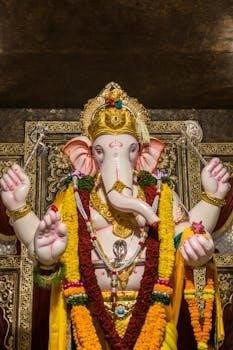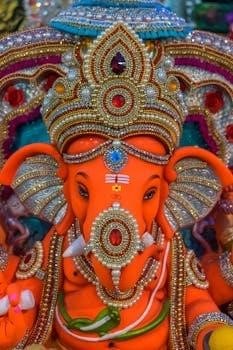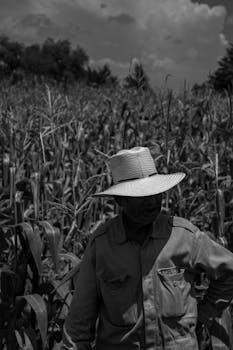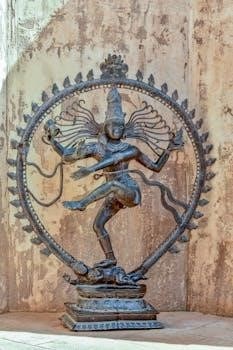Overview of “Lord of the Flies”

William Golding’s “Lord of the Flies” explores a group of British boys stranded on an island. They attempt self-governance‚ but descent into savagery is inevitable. The novel examines civilization versus primal instincts.
Brief Summary of the Novel
“Lord of the Flies‚” penned by William Golding‚ unfolds the tale of British schoolboys marooned on a deserted island after a plane crash during a wartime evacuation. Initially‚ they attempt to establish a semblance of order and civilization‚ electing Ralph as their leader. He advocates for building shelters and maintaining a signal fire to attract rescue.
However‚ as time passes‚ the boys gradually succumb to their primal instincts. Jack‚ a charismatic choirboy‚ challenges Ralph’s authority‚ appealing to their desires for hunting and immediate gratification. The group splinters‚ with Jack leading a tribe focused on hunting pigs and engaging in ritualistic dances. Fear of an imaginary beast further fuels their descent into savagery.
Tragedy strikes as the boys’ actions become increasingly violent. Piggy‚ the intellectual and rational voice‚ is brutally killed. Ultimately‚ the island’s fragile society collapses completely. Just as the boys are consumed by chaos‚ a naval officer arrives‚ bringing a sudden end to their isolated world and forcing them to confront the darkness within themselves.
Themes Explored in the Book
“Lord of the Flies” delves into several profound themes‚ most notably the inherent conflict between civilization and savagery. The novel explores the idea that human nature‚ when stripped of societal constraints‚ tends towards primal instincts and violence. The boys’ descent into savagery illustrates the fragility of order and the ease with which it can be corrupted.
The loss of innocence is another prominent theme. As the boys succumb to their darker impulses‚ they lose their childhood innocence and naiveté. The island setting serves as a microcosm of society‚ revealing the potential for evil that exists within individuals and groups. Power and leadership are also examined‚ highlighting the corrupting influence of unchecked authority.
Fear‚ both rational and irrational‚ plays a significant role in shaping the boys’ behavior. Their fear of the unknown beast drives them further into savagery‚ demonstrating the destructive power of paranoia and superstition. Ultimately‚ “Lord of the Flies” serves as a cautionary tale about the dark side of human nature and the importance of societal structures in maintaining order.

Availability of “Lord of the Flies” in PDF Format
“Lord of the Flies” in PDF format can be found on reputable online bookstores and educational resource websites. These sources ensure a legal and high-quality version of the novel.
Legitimate Sources for Downloading the PDF
Finding a legitimate PDF of “Lord of the Flies” is crucial for respecting copyright and ensuring a quality reading experience. Reputable online bookstores like Amazon Kindle‚ Barnes & Noble Nook‚ and Google Play Books often offer digital versions available for purchase. These platforms provide authorized copies‚ ensuring the text is complete and properly formatted.
Educational websites and online libraries‚ such as Project Gutenberg (though it may not have a PDF) and university digital libraries‚ can sometimes offer free‚ legal access to classic literature. Always check the copyright status and terms of use before downloading. Avoid suspicious websites promising free downloads‚ as these may contain malware or distribute unauthorized copies.
Consider using library apps like Libby or Hoopla‚ which allow you to borrow ebooks‚ including “Lord of the Flies‚” from your local library for free. These apps provide a convenient and legal way to access digital books without compromising copyright laws or risking malware infections.
Risks of Downloading from Unofficial Websites
Downloading a PDF of “Lord of the Flies” from unofficial websites poses several risks. These sites often distribute illegal copies‚ violating copyright laws and potentially leading to legal consequences for the downloader. Furthermore‚ such websites are frequently breeding grounds for malware‚ viruses‚ and other malicious software that can infect your device and compromise your personal information.
The quality of PDFs from unofficial sources is often substandard. The text may be incomplete‚ poorly formatted‚ or contain errors. Additionally‚ these files may be disguised as legitimate documents but contain hidden scripts or executables designed to harm your system.
To protect your device and respect copyright laws‚ it is crucial to obtain digital copies of “Lord of the Flies” from reputable sources. Avoid the temptation of free downloads from unknown websites‚ as the potential risks far outweigh the perceived benefits. Always prioritize safety and legality when accessing digital content.

Character Analysis
Ralph‚ the elected leader‚ embodies order and civilization. He strives to maintain rules and focus on rescue‚ but faces challenges as the boys succumb to primal instincts and savagery.
Ralph
Ralph emerges as the initial leader due to his charisma and desire for order. He represents the values of civilization‚ democracy‚ and long-term planning‚ striving to maintain a signal fire for rescue. His leadership is challenged by Jack’s increasing influence and the boys’ descent into savagery.
Ralph’s commitment to rules and reason clashes with the primal urges that begin to dominate the group. He struggles to maintain focus on their original goal of rescue‚ facing resistance from boys who prioritize hunting and immediate gratification. As the island’s environment deteriorates‚ so does Ralph’s authority.
He symbolizes the dwindling hope for civilization amidst the growing chaos. Ralph’s character arc highlights the fragility of order when confronted with the inherent darkness within human nature. His eventual flight from Jack’s tribe underscores the triumph of savagery.
Jack
Jack Merridew embodies the descent into savagery and the allure of primal instincts. Initially the head choirboy‚ he craves power and control‚ challenging Ralph’s leadership from the outset. He represents the primal‚ emotional side of human nature‚ prioritizing hunting and immediate gratification over reason and long-term planning.
Jack’s influence grows as he taps into the boys’ baser instincts‚ offering them the thrill of the hunt and freedom from rules. He establishes a tribe based on fear and charisma‚ manipulating the boys with promises of food and protection from the “beast.” His painted face becomes a mask‚ allowing him to shed his civilized identity and embrace savagery fully.
Jack’s character symbolizes the destructive nature of unchecked power and the ease with which civilization can crumble in the face of primal urges. His transformation highlights the dark side of humanity;
Piggy
Piggy is the intellectual and rational counterpoint to the other boys‚ representing intellect and civilization. Physically vulnerable and socially awkward‚ he is often ridiculed and marginalized. Despite this‚ Piggy consistently advocates for reason‚ order‚ and the importance of rules. His glasses symbolize clarity of vision and the power of intellect‚ essential for survival.
Piggy serves as Ralph’s advisor‚ providing logical solutions to problems and reminding him of their initial goals. He clings to the idea of civilization‚ desperately trying to maintain order and prevent the boys from succumbing to savagery. His unwavering belief in reason makes him a target for Jack and his tribe‚ who reject intellect in favor of primal instincts.
Piggy’s tragic fate underscores the vulnerability of intellect and reason in the face of unchecked savagery. His death symbolizes the loss of logic.

Symbolism in “Lord of the Flies”
Golding employs rich symbolism‚ with objects and settings representing abstract ideas. The island embodies isolation‚ and the boys’ descent reveals humanity’s inherent nature. Key symbols enhance the novel’s themes.
The Conch Shell
The conch shell is a central symbol in “Lord of the Flies‚” representing order‚ democracy‚ and civilized discourse. Initially‚ Ralph uses the conch to call assemblies‚ establishing a system where whoever holds the shell has the right to speak. This signifies a structured society based on rules and mutual respect. The conch becomes a tangible representation of the boys’ attempts to maintain order amidst their increasingly chaotic situation.
As the boys descend further into savagery‚ the conch’s power diminishes. Jack and his tribe disregard the conch’s authority‚ prioritizing hunting and primal instincts over rational discussion. The gradual erosion of the conch’s significance mirrors the disintegration of the boys’ civilized facade. Eventually‚ the conch is shattered along with Piggy‚ symbolizing the complete collapse of order and reason on the island. The destruction of the conch signifies the triumph of savagery over civilization‚ highlighting Golding’s pessimistic view of human nature.
Piggy’s Glasses
Piggy’s glasses are a potent symbol in “Lord of the Flies‚” representing intellect‚ reason‚ and scientific clarity. Piggy‚ the intellectual of the group‚ relies on his glasses to see and function effectively. The glasses become essential for survival as they are used to start fire‚ a crucial element for rescue and maintaining a connection to civilization. The boys initially respect Piggy’s glasses for their practical value‚ recognizing their importance in creating fire.
However‚ as savagery takes hold‚ the glasses become a target. Jack and his hunters steal the glasses‚ using them to start their own fires for hunting and feasts. This theft symbolizes the rejection of intellect and the embrace of primal instincts. The broken glasses represent the boys’ diminishing capacity for rational thought and foresight. Ultimately‚ the complete shattering of Piggy’s glasses coincides with his death‚ signifying the final triumph of savagery over reason and intellect on the island.
The Island Itself
The island in “Lord of the Flies” is a multifaceted symbol‚ representing both paradise and the inherent isolation of humanity. Initially‚ the island appears as an Edenic escape‚ offering the boys freedom from adult supervision and the constraints of civilization. Its lush environment and abundant resources promise a self-sufficient existence.
However‚ the island’s isolation quickly becomes a breeding ground for the boys’ inner demons. The absence of societal rules and authority allows their primal instincts to surface‚ transforming the island into a microcosm of human nature. As the boys descend into savagery‚ the island reflects their deteriorating state. The once-pristine beaches become littered with debris‚ and the forest‚ initially a source of wonder‚ becomes a place of fear and superstition.
The island‚ therefore‚ serves as a blank canvas onto which the boys project their own desires‚ fears‚ and ultimately‚ their inherent capacity for both good and evil.